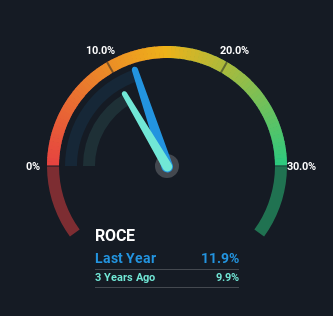E. Pairis (ATH:PAIR) Is Reinvesting At Lower Rates Of Return
Did you know there are some financial metrics that can provide clues of a potential multi-bagger? Amongst other things, we'll want to see two things; firstly, a growing return on capital employed (ROCE) and secondly, an expansion in the company's amount of capital employed. If you see this, it typically means it's a company with a great business model and plenty of profitable reinvestment opportunities. Although, when we looked at E. Pairis (ATH:PAIR), it didn't seem to tick all of these boxes.
Return On Capital Employed (ROCE): What Is It?
Just to clarify if you're unsure, ROCE is a metric for evaluating how much pre-tax income (in percentage terms) a company earns on the capital invested in its business. The formula for this calculation on E. Pairis is:
Return on Capital Employed = Earnings Before Interest and Tax (EBIT) ÷ (Total Assets - Current Liabilities)
0.12 = €1.3m ÷ (€18m - €7.4m) (Based on the trailing twelve months to December 2023).
Therefore, E. Pairis has an ROCE of 12%. That's a relatively normal return on capital, and it's around the 11% generated by the Packaging industry.
View our latest analysis for E. Pairis

Historical performance is a great place to start when researching a stock so above you can see the gauge for E. Pairis' ROCE against it's prior returns. If you want to delve into the historical earnings , check out these free graphs detailing revenue and cash flow performance of E. Pairis.
What Does the ROCE Trend For E. Pairis Tell Us?
In terms of E. Pairis' historical ROCE movements, the trend isn't fantastic. Over the last five years, returns on capital have decreased to 12% from 28% five years ago. Given the business is employing more capital while revenue has slipped, this is a bit concerning. If this were to continue, you might be looking at a company that is trying to reinvest for growth but is actually losing market share since sales haven't increased.
On a side note, E. Pairis has done well to pay down its current liabilities to 41% of total assets. That could partly explain why the ROCE has dropped. What's more, this can reduce some aspects of risk to the business because now the company's suppliers or short-term creditors are funding less of its operations. Since the business is basically funding more of its operations with it's own money, you could argue this has made the business less efficient at generating ROCE. Keep in mind 41% is still pretty high, so those risks are still somewhat prevalent.
The Bottom Line
We're a bit apprehensive about E. Pairis because despite more capital being deployed in the business, returns on that capital and sales have both fallen. The market must be rosy on the stock's future because even though the underlying trends aren't too encouraging, the stock has soared 319%. Regardless, we don't feel too comfortable with the fundamentals so we'd be steering clear of this stock for now.
Since virtually every company faces some risks, it's worth knowing what they are, and we've spotted 5 warning signs for E. Pairis (of which 2 make us uncomfortable!) that you should know about.
While E. Pairis isn't earning the highest return, check out this free list of companies that are earning high returns on equity with solid balance sheets.
Valuation is complex, but we're here to simplify it.
Discover if E. Pairis might be undervalued or overvalued with our detailed analysis, featuring fair value estimates, potential risks, dividends, insider trades, and its financial condition.
Access Free AnalysisHave feedback on this article? Concerned about the content? Get in touch with us directly. Alternatively, email editorial-team (at) simplywallst.com.
This article by Simply Wall St is general in nature. We provide commentary based on historical data and analyst forecasts only using an unbiased methodology and our articles are not intended to be financial advice. It does not constitute a recommendation to buy or sell any stock, and does not take account of your objectives, or your financial situation. We aim to bring you long-term focused analysis driven by fundamental data. Note that our analysis may not factor in the latest price-sensitive company announcements or qualitative material. Simply Wall St has no position in any stocks mentioned.
Have feedback on this article? Concerned about the content? Get in touch with us directly. Alternatively, email editorial-team@simplywallst.com
About ATSE:PAIR
E. Pairis
Produces and sells plastic products made of polyethylene, polypropylene, and terepthalic polyethylene in Greece.
Solid track record with mediocre balance sheet.
Market Insights
Community Narratives



